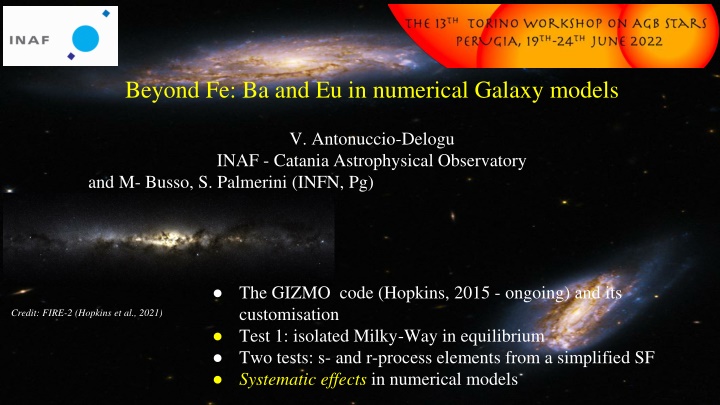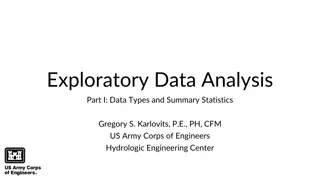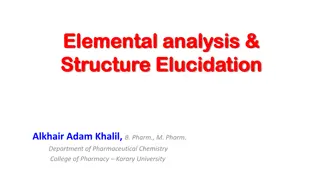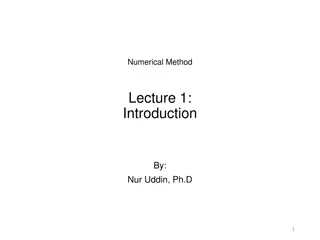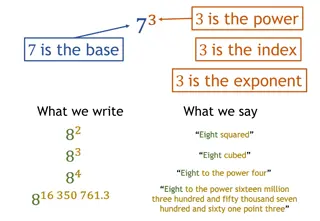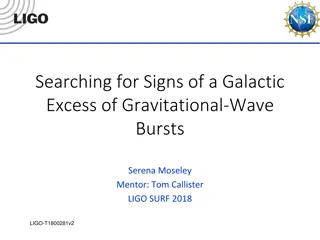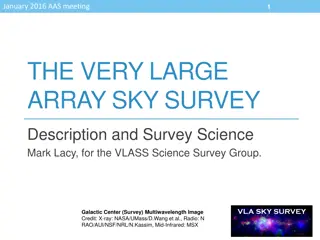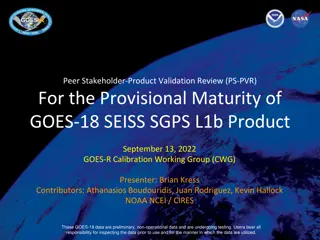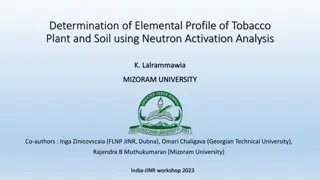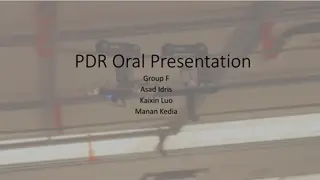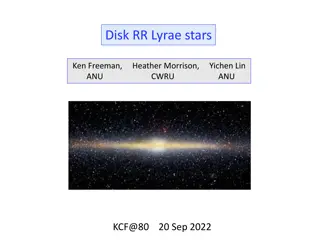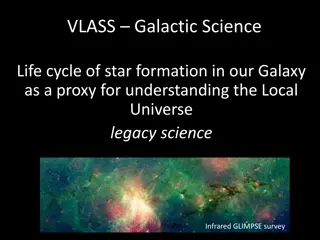Customising Numerical Models for Galactic Elemental Abundance Tracking
This study delves into customizing numerical models to track production of selected elemental species in a Milky Way-type galaxy. The GIZMO code by Hopkins (2015) offers versatile numerical methods, including cooling, star formation, and feedback mechanisms. The experiments focus on an isolated galaxy setup with specific mass parameters, following a concordance cosmological model. Furthermore, the customization of stellar feedback processes involves sources of key elements such as Ba and Eu, incorporating data from recent calculations. The study also examines TP-AGB winds and Neutron Star Mergings to enhance the fidelity of the galaxy simulation.
Download Presentation

Please find below an Image/Link to download the presentation.
The content on the website is provided AS IS for your information and personal use only. It may not be sold, licensed, or shared on other websites without obtaining consent from the author.If you encounter any issues during the download, it is possible that the publisher has removed the file from their server.
You are allowed to download the files provided on this website for personal or commercial use, subject to the condition that they are used lawfully. All files are the property of their respective owners.
The content on the website is provided AS IS for your information and personal use only. It may not be sold, licensed, or shared on other websites without obtaining consent from the author.
E N D
Presentation Transcript
Beyond Fe: Ba and Eu in numerical Galaxy models V. Antonuccio-Delogu INAF - Catania Astrophysical Observatory and M- Busso, S. Palmerini (INFN, Pg) The GIZMO code (Hopkins, 2015 - ongoing) and its customisation Test 1: isolated Milky-Way in equilibrium Two tests: s- and r-process elements from a simplified SF Systematic effects in numerical models Credit: FIRE-2 (Hopkins et al., 2021)
GIZMO (Hopkins, 2015): different numerical methods (MFM to classical SPH), cooling (cont. and line), star formation (from SSP down to single stars), feedback (default: as in AGORA-2 code comparison project) Versatile, highly tested, good scaling. Comparison with Gadget 2: more sophisticated numerical method, adaptive Voronoi-like mesh Main target: customize to track production of selected p- and s elements. Requires detailed recipes for subgrid physics: SF, SNIa and SNII, stellar feedback from TP-AGB (winds), and models of their diffusion in the host galaxy. This work: isolated MW-type galaxy. ICs created using DICE (Perret, 2014), stable equilibrium forming a m=2 spiral structure.
Numerical experiments Isolated MW-type, Mh= 7.4x1011M , Mbulge= 1.55x1010M , Mgas= (8.2 + 1.3)x109M , Mdisk= 3.65x1010M (model B2 from de Salas et al., 2019) Concordance cosmological model: M=0.3089, =0.6911, bar=0.0486, h0= 0.6774 (baryonic) mass resolution: mbar= 1.217x104M , mgas= 3.167x103M Lbox= 100 h-1kpc , zin= 4 , tin= 138 Myr MFM hydro solver, cooling (GRACKLE, 10 T 109K) both synchr. and metal-line , mechanical feedback, complete SF criterion (incl. v < 0, nthr= 103e-cm-3)
Customising stellar feedback Only SNII feedback is available with the default version of GIZMO Added: Neutron Star Mergings, low mass TP-AGB star winds Eu sources: 1. Type II SN: from 20 Mpre-SN* 50 M ), yield = 3x10-9for each event 2. SNIa: from binaries having: 9 M1,2 50 M , yield ~ 3x10-7 Ba sources: 1. Type II SN: yield 3.5x10-8 2. TP-AGB winds: (1 M* 3 M ) yields given by recent calculations from Busso, Kratz, Palmerini et al. (2022)
TP-AGB winds 1. Low mass stars leaving the MS at each given time t inenter the TP-AGB phase on a timescale tstep, i.e. without any delay. 2. 1 M* 3 M MS lifetime: 342.83 MS (M*) 104 Myr at each timestep we record MAGB(t), the typical mass switching on the TP-AGB wind. 3. The duration of the wind is calculated by a fit to the results from Marigo (2022): w(M*) w0M* exp(-M*/ Mw), with =2.33, w0=9.13 Myr, Mw=0.9 M . 4. Mass loss rate: = 10-2M*Gyr-1(average over a Chabrier IMF) 5. Wind velocity: vw= 30 km sec-1, indep. of M*. 4. and 5. consistent with Hopkins et al., arxiv 2203.00040, eqs. (4) and (5).
NS mergers 1. Delay Time Distribution fMNS( ) from Simonetti et al. (2019): We choose their optimal model =-1.5. 2. NSM rate: ( ): SF rate (from num. SSP), MNS, k fixed by IMF. 3. Each SNIa releases 2 M and 1050erg into the ISM.
A slowly decreasing radial abundance profile settles already at z~ 1.5, consistent with previous results. Now a very different test: evolution of Ba and Eu only produced by events induced by a m=2 spiral structure, forcing SF to take place only there.
What are we probing with this numerical experiment 1. Dynamical injection of protoypical r- and s-processes elements (Eu and Ba, resp.) from NSMs and TP-AGBs resp. 2. Equilibrium, isolated disc of MW type spiral structure, negligible radial motions What is outside its scope 3. Role of satellite merging and other dynamical large scale perturbations radial migration, mixing, not in-situ mixing Two sets of runs, Zin= 10-4 A. t*,in= 0 AGB winds switched after t 340 Myr B. t*,in= t(zin) 340 Myr AGB winds switched immediately
Set A: Metallicitys radial gradient stars gas Smoothing of radial gradients is driven by the global dynamics: SF regions mostly driven and synchronised by a m=2 grand design spiral.
No differences seen between case A and B winds play a negligible role in shaping the Z distribution. Set A Z distr. does not depend on distance. This is a result of the combined action of SNs and spiral structure driving. Set B winds play a negligible role in shaping the global Z distribution and/or creating global Z gradients.
Enrichments dependence on SFR Sources of Ba and Eu enrichment are different, yet both are controlled by SFR. gas Case A (no initial winds): no correlations emerge between Ba/Eu abundance and SFR in the gas phase stars For stars the positive correlation with SSP s age is expected, as in GIZMO SSPs older SSPs recycle more enriched gas.
Delayed vs early winds CaseA (delayed) CaseA CaseB The prompt release of winds helps the diffusion both of Ba and Eu. A possible negative correlation between Ba and SFR emerges in the gas phase as a consequence of the locking of the latter in successive stellar generations.
Final caveats: Systematics in numerical methods Can we trust the way numerical codes treat the coupling between feedback sources (SN, winds) and the ISM? GIZMO (Hopkins, 2018): star particles hosting SNe have no ISM. ESN, pSNdelivered to faces of underlying Voronoi (foam) grid structure.
Why should we care about where inside a star particle a SN explodes (or wind propagate)? Gatto et al., 2015: the net energy/momentum/mass throughputs of stellar feedback events do depend on where inside the SSP/star-particle the source is located. The turbulence induced by the event inside the ISM of the SSP itself modulates the delivery to the external environment, both quantitatively and in its temporal sequence.
Chaikin et al., 2022 investigated the impact of five numerically and physically motivated ways to deliver the stellar feedback on the global final structure of the ISM in isolated MW-type galaxies. Below the corresponding differences in the ISM density.
Prospects A sensible way to overcome the systematics: exploit effective computational tools: A Python interface to glue together the galactic and subgalactic scale physics The SF subgrid (BF) is embedded in the galactic grid (LF) 1. BFand LFare taken in charge by different comp. partitions (computing nodes), in a load balanced way (the interface) 2. Star formation in BF is treated by FLASH + PySPH, to propagate feedback towards LFand viceversa. 3. The overhead from the interface is at most 7% of the total computing time.
